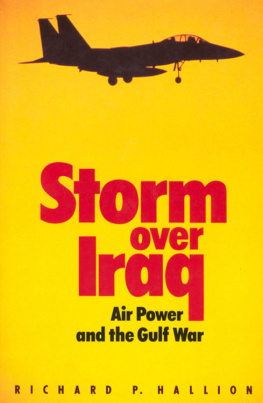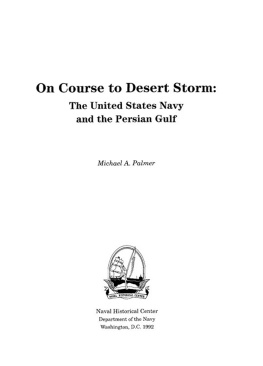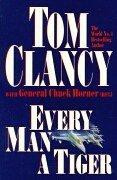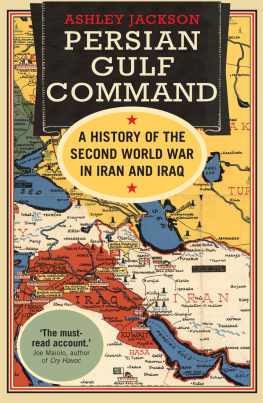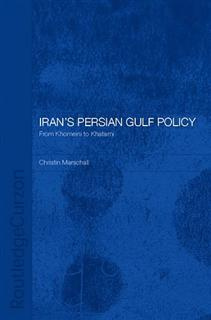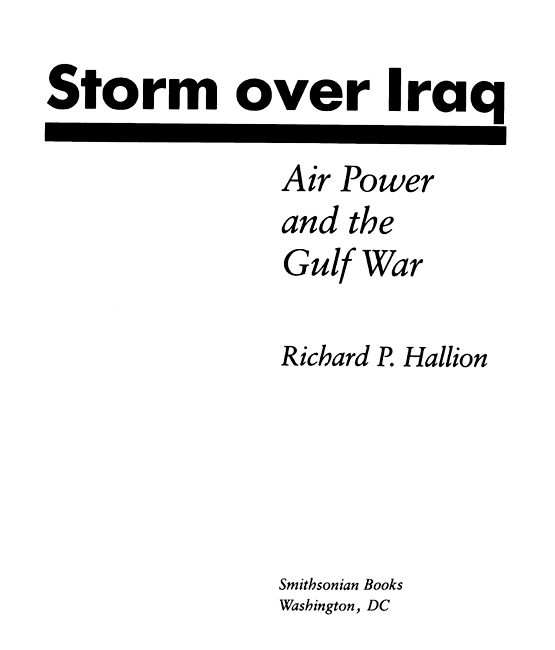Copyright 1992 by Smithsonian Books
All rights are reserved
This book was edited by Initial Cap Editorial Services.
Print production editor: Jack Kirshbaum
Designer: Chris Hotvedt/Janice Wheeler
Maps: Blue Heron, Inc.
Library of Congress Cataloging in Publication Data
Hallion, Richard.
Storm over Iraq / Richard P. Hallion.
p. cm.(Smithsonian history of aviation series)
Includes bibliographical references and index.
ISBN 1-56098-190-3 (cloth); 1-56098-723-5 (paper)
1. Air powerUnited StatesHistory. 2. United States. Air ForceHistory. 3. Persian Gulf War, 1991Aerial operations, American. I. Title. II. Series.
UG633.H35 1992
358.4030973dc20 92-7034
eBook ISBN: 978-1-58834-519-6
Unless otherwise stated, all photographs are courtesy of U.S.
Department of Defense.
For permission to reproduce individual illustrations appearing in this book, please correspond directly with the owners of the images, as stated in the picture captions. Smithsonian Books does not retain reproduction rights for these illustrations individually or maintain a file of addresses for photo sources.
This book may be purchased for education, business, or sales promotional use. For information please write: Special Markets Department, Smithsonian Books, P.O Box 37012, MRC 513, Washington, DC 20013.
www.SmithsonianBooks.com
v3.1
To the men and women who flew in Desert Storm, and, especially, to the memory of
Lieutenant Colonel Bryant Dougherty, USAF who rode their wings.
You give wonderful comrades to me, the faithful who dwell in your land
Contents
Preface
A decade has passed since Saddam Hussein triggered the Gulf crisis of 1990-91. Since that time, a variety of crises have occurred around the world. Nevertheless, across the spectrum of conflict, and in vastly different circumstances and geographical locales than that of Iraq and Kuwait, the lessons learned in the Gulf war have held up. Chief among these has been the importance and decisiveness of modern joint service aerospace power. So profound has been the change in warfare exemplified by what occurred in Desert Storm, that, for the United States, aerospace power is now de facto accepted as the natural and logical form of crisis intervention.
For example, the same high-capacity airlift capabilities that proved so critical to the coalition success in fighting Iraq in 1991 have proven vitally significant for humanitarian operations as well. In late July 1994 tribal genocide and civil war had led to a massive humanitarian disaster in Rwanda. Tens of thousands of refugees housed in unsanitary camps suffered from cholera, and subsequently dysentery, with deaths numbering over 6,500 per day. An emergency medical airlift (Operation Sustained Hope) began on July 26, delivering military personnel and expert help that succeeded in reducing the death rate to peacetime regional norms (about 40-50 per day) by August 18. In short, key airlifts helped end two epidemics and save thousands of lives.
Rapid, responsive aerospace power is particularly well-suited for the confused and complex post-Cold War (and post-Desert Storm) world, particularly since the dividing line between humanitarian and combat operations is often blurred, or even nonexistent. Beginning in 1992, the United States began a sustained commitment to assist the troubled region of the Balkans. At first, this consisted of airlift operations (Operation Provide Promise) delivering food and medical supplies across Bosnia. But the next year, this had to be expanded into deterring Serb air attacks via fighter patrols and airborne early-warning monitoring across the region (Operation Deny Flight). After a highly publicized shootdown of four Serb attack aircraft by two F-16s, Serb air attacks ceased. Then, in 1995, in the face of continued ground conflict and egregious Serb behavior against safe areas, NATO aerospace power was used to halt this aggression (Operation Deliberate Force) and set the stage for the signing of the Dayton Peace Accords that resulted in the stabilization of Bosnia and the insertion of a peace-keeping force into the region.
While Deliberate Force ended well in Bosnia, the continued brutality of the Slobodan Milosevic regime against the Kosovar Albanians created another crisis that rapidly grew in intensity, resulting in growing international unease and concern. After diplomatic efforts and threats of force failed to deter Yugoslavian behavior, NATO resorted to aerospace power (Operation Allied Force), beginning on March 24, 1999. Rapid air attacks by a full range of NATO aircraft followed, including the combat debut of the Northrop B-2 Spirit stealth bomber (flying nonstop from the continental United States and dropping up to 16 precision munitions against 16 different targets on a single sortie), as well as showers of air-and-surface-launched cruise missiles. These attacks denied the Milosevic regime the ability to mass forces, hindering their genocidal behavior against the Albanian citizens of Kosovar, most of whom fled the country. They also targeted the Yugoslavian military infrastructure, including munitions stockpiles, manufacturing complexes, airfields, and key bridges. Altogether, NATO airmen flew over 33,000 sorties and struck hundreds of targets, ranging from Yugoslavian troop concentrations attacked by B-1 and B-52 bombers, to tanks and artillery attacked by A-10s and F-16s, to bridges and key strategic targets in the Belgrade region attacked by F-117 and B-2 stealth aircraft. On June 21, with rising public outcry at home against his regime, Milosevic capitulated to NATOs demands, removing his forces from Kosovo. A year later, as public resentment over his regime continued to grow, he was gone from office.
Allied Force constituted not only a key win for NATO and the cause of European stability, but for the significance and decisiveness of postDesert Storm precision aerospace power as well, and the whole notion of effects-based warfare. Indeed, it drew the attention of the worlds political and military commentators in a fashion that even Desert Storm had not. Unlike Desert Storm, not a single NATO platoon nor a single NATO tank had crossed into Yugoslavia or Kosovo before Milosevic gave up. John Keegan, distinguished military historian and defence editor of The Daily Telegraph, tellingly noted that
There are certain dates in the history of warfare that mark real turning points. Now there is a new turning point to fix on the calendar: June 3, 1999, when the capitulation of President Milosevic proved that a war can be won by air power alone. There is still a great deal to do before air power theory can be fully integrated into the diplomacy and strategy of preserving world order [but] the air forces have won a triumph, are entitled to every plaudit they will receive and can look forward to enjoying a transformed status in the strategic community, one they have earned by their single-handed efforts.
All this can be said without reservation, and should be conceded by the doubters, of whom I was one, with generosity. Already some of the critics of the war are indulging in ungracious revisionism, suggesting that we have not witnessed a strategic revolution and that Milosevic was humbled by the threat to deploy ground troops or by the processes of traditional diplomacy. All to be said to that is that diplomacy had not worked before March 24, when the bombing started, while the deployment of a large ground force, though clearly a growing threat, would still have taken weeks to accomplish at the moment Milosevic caved in. The revisionists are wrong. This was a victory through air power.

